| Home |
| History |
| People |
| Places |
| Trees |
| Sources |
| Stories |
| DNA |
| Spratley |
| Latest |
| Contact |
| Login |
Pratley DNA StudyIn an attempt to bridge the gap between the 1600s and the 1700s which has been left by the missing baptism register, and determine how all the various branches of the Pratley family are related, I've set up a DNA project with FamilyTreeDNA. If we can get as many male Pratleys as possible to participate, we should be able to build up a picture of how each line descends from William Spratley. So if you are (or know of!) a male Pratley, and are interested in taking part in this project, please get in touch to discuss submitting a test kit. The results will remain completely anonymous - only you and I will know which set of results are yours. The cost of a test kit is around £85, though I will of course contribute to this. In order to reduce the number of test kits (and save a bit of money!), only one representative from each family is needed. So if your brother/father has already taken part, you don't need to as well. Hopefully the technology of the 21st century will help to solve the puzzle of the 17th century! Results so far: The raw DNA dataThe raw data that has been gathered so far can be seen here on FamilyTreeDNA's site.The results in the red "Main Pratley branch" section form the backbone of the results. They differ from each other by only a handful of mutations, which not only shows that they are related within the last 20 or so generations, but more importantly the differences give an indication of how the ancestors of the testers are connected. A few notes on the data in this section:
The results in the pink "Potters Hill Lodge Pratley branch" section don't match the main body of the results, so this branch of the family must have had a female Pratley ancestor some time before the common ancestor of the two testers. The results in the beige "Joseph Guy b.1812 descendants" section have a couple of results which match the main body of the results, and so show that Joseph Guy's father was indeed a Pratley, presumably Joseph Pratley as his mother had stated. Of the two Joseph Pratleys of the right age from the right place, one descends from the Potters Hill Lodge Pratleys, and so would have had a different Y-DNA signature (see above). So it seems likely that the other Joseph Pratley, born 1794 to Michael Pratley, was Joseph Guy's father. (The remainder of the results don't match the main set of results, so had a female Pratley ancestor in the past, but more tests are needed to determine when this might have been.) Results so far: Applying the DNA data to the known branchesMain Pratley branch (including Joseph Guy branch)At the top of the graph is the tree of mutations from the proposed "original" Pratley markers. At the bottom of the graph are the known ancestors of the testers, based on the paper-based research. The boxes show which testers have which mutations, and so allows us to overlay the ancestry of the testers onto the shape of the tree of mutations. Some points of interest:
"Potters Hill Lodge" Pratley branchWe have two results from the Pratley branch that descends from John Pratley of Potters Hill Lodge. Again, the graph shows the tree of mutations at the top, and the known ancestry of the two testers at the bottom, with boxes to show how the top half maps to the bottom.
|

